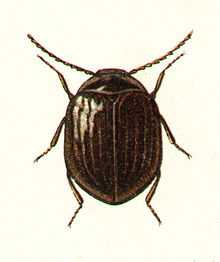Water-penny beetles
| Water-penny beetles | |
|---|---|
 | |
| Larva | |
| Scientific classification | |
| Kingdom: | Animalia |
| Phylum: | Arthropoda |
| Class: | Insecta |
| Order: | Coleoptera |
| Suborder: | Polyphaga |
| Superfamily: | Byrrhoidea |
| Family: | Psephenidae Lacordaire, 1854 [1] |
| Subfamiliae | |
|
Eubrianacinae Jacobson, 1913 | |

Water-penny beetles are a family (Psephenidae) of aquatic beetles. The young, which live in water, resemble pennies. The larvae feed off of algae, larvae, and feces. The presence of water penny larvae in a stream can be used as a test for the quality of the water. Among the pollution sensitivity categories sensitive, somewhat-sensitive, and tolerant; water pennies belong to the sensitive category. They cannot live in habitats where rocks acquire a thick layer of algae, fungi, or inorganic sediment. Therefore, their presence along with other diverse phyla signifies good quality water. They are around 6 to 10 millimeters in length.[2]
A water penny larvae's shell are oval shaped to almost circular and is commonly a copper color, which explains the name, 'Water Penny.' Water Pennies obtain oxygen through their membrane and through feathery gills located at the base of the abdomen. They are typically found in riffles in streams with a moderate to fast current, clinging to the underside of logs or rocks. Occasionally, they can be found on rocks along the shores of lakes. Attached to the legs are scrapers, which are used to scrape the algae from the surface of a log or rock. Usually found in Eastern United States and Canada, Water Pennies are occasionally discovered in Southwest United States.
As adults, water pennies become terrestrial.
References
External links
| Wikimedia Commons has media related to Category:Psephenidae. |